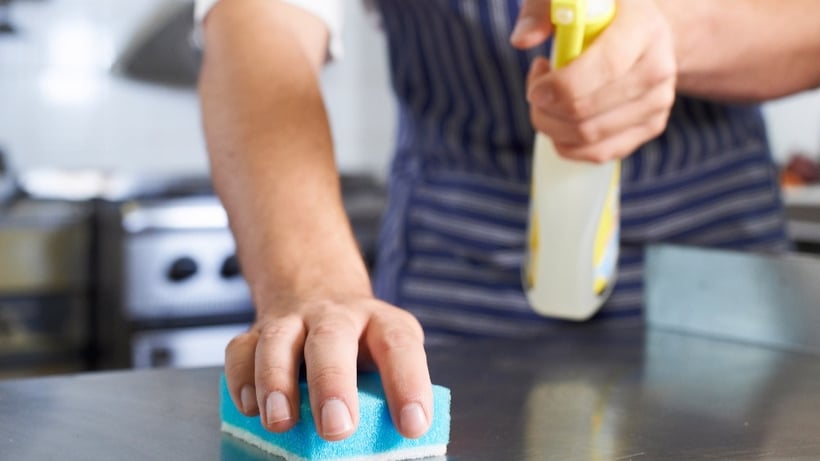
The kitchen is often considered the heart of any restaurant or commercial food establishment. While culinary professionals are well-versed in food safety practices, the importance of chemical safety cannot be overlooked. The Workplace Hazardous Materials Information System (WHMIS) is critical to maintaining a healthy kitchen environment.
In this blog, we will provide a comprehensive overview of WHMIS, the WHMIS Course and how obtaining a WHMIS Certificate in Canada can benefit commercial kitchen settings.
What Is WHMIS?
The Workplace Hazardous Materials Information System (WHMIS) is Canada's national standard for hazard communication associated with hazardous materials in the workplace. Implemented in 1988 and updated in 2015 to align with the Global Harmonized System of Classification and Labelling of Chemicals (GHS), WHMIS aims to protect the health and safety of workers.
WHMIS consists of three key elements:
- Labels: Hazardous materials must be labelled standardized to provide critical safety information clearly and concisely. These labels usually include symbols to signify the hazard type, precautionary measures, and first-aid instructions.
- Safety Data Sheets (SDS): These are comprehensive documents that provide detailed information about the properties of a hazardous material. SDS includes information on a dangerous substance's composition, safety precautions, potential health and safety risks, and safe storage, handling, and disposal guidelines. In the kitchen, Safety Data Sheets are often kept in designated folders or binders near chemical storage areas or digitally in workplace intranet systems.
- Education and training: WHMIS mandates worker training programs to educate employees on understanding and interpreting labels and SDS and working safely with hazardous materials. Practical applications could include safely diluting cleaning agents or using the proper personal protective equipment when handling caustic substances.
|
Element |
What it covers |
Why it matters in a kitchen |
|
Hazard labelling |
Standardised labels on chemical products indicating hazard class, pictogram, precautionary measures |
Helps kitchen staff immediately recognise risks and handle chemicals safely |
|
Safety Data Sheets (SDSs) |
Documents detailing composition, hazards, safe handling, storage, first-aid, disposal information |
Provides detailed guidance and legal compliance information for chemical management |
|
Worker education & training |
Training on understanding labels, interpreting SDSs, safe handling and emergency response |
Empowers employees to prevent chemical contamination, protect themselves, and maintain food safety |
What Exactly Are Hazardous Materials?
Several items might fall under the WHMIS guidelines for hazardous materials in a commercial kitchen. Some of these include:
- Cleaning agents: Various cleaning chemicals used to sanitize countertops, floors, and kitchen appliances may contain hazardous substances. This could include disinfectants, oven cleaners, and degreasers.
- Pesticides: Sprays or powders used to control pests like flies, cockroaches, or rodents could be hazardous and require proper labelling and storage.
- Caustic soda: Often used for heavy-duty cleaning or drain clearing, caustic soda can cause severe burns upon contact with skin and can be fatal if ingested.
- Bleach: A common sanitizing agent, bleach is highly corrosive and can cause damage to skin and eyes.
- Ammonia: Frequently used for cleaning, ammonia vapours can be hazardous when inhaled, and the substance can be corrosive.
- Aerosols: Certain aerosolized products like non-stick cooking sprays or air fresheners could be flammable or harmful if inhaled.
- Acids: Some specialty kitchens may use stronger acids like hydrochloric or sulfuric acid for particular culinary techniques or cleaning tasks. These are corrosive and can cause severe harm.
- Alcohol: High-proof alcohol used in cooking or flambéing can be highly flammable and must be treated carefully.
- Compressed gas cylinders: Carbon dioxide for soda machines or nitrogen for specific cooking techniques are stored under high pressure and can be hazardous if not handled correctly.
- Fire extinguishers: While they are a safety measure, the chemicals used in some fire extinguishers can be hazardous if misused.
Each of these items requires appropriate WHMIS labelling, storage and handling procedures to ensure the safety of all staff in the commercial kitchen.
Employers must ensure that their staff are adequately trained and knowledgeable about the hazardous materials they may encounter. In many cases, completing this training leads to issuing a WHMIS Certificate, which is proof of competency in the safe handling of hazardous materials.
WHMIS is enforced by federal and provincial regulations, making it applicable across various industries and settings, including commercial kitchens where chemicals and hazardous materials are present.
Importance of WHMIS Training in Commercial Kitchens
Commercial kitchens are bustling environments filled with various equipment and substances, including cleaning agents, degreasers and even certain food additives, which can be classified as hazardous materials. WHMIS training teaches kitchen staff how to handle, store and dispose of these substances responsibly and safely. Without proper training, mishandling can lead to injuries, such as burns, or even long-term health implications.
Safety Ahead: Next Steps with WHMIS and CIFS
While commercial kitchens are primarily focused on food production and service, the significance of chemical safety through WHMIS training should not be underestimated. WHMIS is an essential framework for educating and equipping kitchen staff with the knowledge and skills to handle hazardous materials safely. From understanding labelling systems to consulting Safety Data Sheets, WHMIS helps to maintain a secure and health-conscious work environment.
For restaurant and food establishment owners seeking to optimize both food and chemical safety in their operations, the Canadian Institute of Food Safety (CIFS) offers comprehensive training programs, including the official WHMIS Course.





